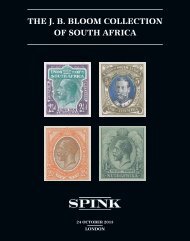bentley priory - Spink
bentley priory - Spink
bentley priory - Spink
Create successful ePaper yourself
Turn your PDF publications into a flip-book with our unique Google optimized e-Paper software.
September 6, 2012 - LONDON<br />
D.S.O. London Gazette 17.11.1944 Wing Commander Robert Jerram Gosnell, D.F.C. (33002), R.A.F., 571<br />
Sqn. [in a joint citation with Acting Squadron Leader William Craig Brodie, D.F.M. and Acting Squadron<br />
Leader Edward John Greenleaf (both awarded the D.S.O.); Acting Flight Lieutenant Kenneth Robert Triggs,<br />
D.F.C. (awarded a Bar to the D.F.C.); and Flight Lieutenant William Irving Drinkall, Acting Flight Lieutenant<br />
Andrew Wesley Lockhart, A.F.C., Flying Officer Richard Wortley Mclernon, and Flying Officer Joseph Ralph<br />
Wood (awarded the D.F.C.)]<br />
‘One night in October, 1944, a force of bombers was detailed for an important low level mining mission, an<br />
operation requiring considerable skill and accuracy in flying. The target was strongly defended by heavy and light<br />
anti-aircraft guns, searchlights, and balloons. Undeterred by these hazards and the most adverse weather, the<br />
operation was completed successfully. The success achieved reflects the greatest credit on them.’<br />
The Recommendation, dated 10.10.1944, states: ‘On the night of the 5th-6th October 1944 Wing Commander<br />
Gosnell was the pilot of a Mosquito aircraft detailed to lay mines from a low altitude in the Kiel Canal. The<br />
waterway is heavily defended by heavy and light anti-aircraft guns, searchlights, and balloons, demanding a high<br />
degree of skill and determination from those detailed for the task. Undeterred by these hazards, Wing<br />
Commander Gosnell brought his aircraft down to 300 feet at the correct speed and released the mine in the<br />
allotted area while under the close range fire of three anti-aircraft guns on the banks of the canal.<br />
As Squadron Commander, this officer was responsible for planning the operation in 571 Squadron and the<br />
success achieved is a reflection on his courage, skill, and sense of duty. Wing Commander Gosnell has completed<br />
34 operational sorties of which 5 have been on Mosquitos. I strongly recommend the Immediate award of the<br />
Distinguished Service Order.’<br />
D.F.C. London Gazette 8.4.1941 Squadron Leader Robert Jerram Gosnell (35002), No. 38 Squadron, Royal Air<br />
Force<br />
The Recommendation, dated 20.3.1941, states: ‘Squadron Leader Gosnell has commanded a flight in this<br />
Squadron since 14.8.1940 and has completed some 23 operational sorties. This officer has always shown<br />
determination, zeal, and keenness in operating against the enemy. Squadron Leader Gosnell has proved an<br />
excellent leader and has set a magnificent example to the younger pilots in his flight. On a recent operation on<br />
Rhodes Island Squadron Leader Gosnell attacked 4 separate targets, namely the aerodromes of Lindos, Maritza,<br />
Kattavia, and Rhodes Harbour. This attack, which was carried out with great determination, resulted in the<br />
destruction of 2 aircraft at Lindos and an ammunition dump at Kattavia.’<br />
Group Captain Robert Jerram Gosnell, D.S.O., D.F.C., born Bangkok, Thailand, 1911; Commissioned Pilot<br />
Officer, Royal Air Force, 23.7.1932, he served initially with No.5 Squadron in Quetta, India for three years.<br />
Promoted Flying Officer, 23.1.1934; and advanced Squadron, 1.4.1939, Gosnell served during the Second<br />
World War with No.38 Squadron (Wellingtons), Marham- his first operational sortie was a raid over Frankfurt,<br />
16.8.1940, followed by the end of the month with a raid over Berlin; targets in September of that year included<br />
Brussels (14.9.1940), Calais (20.9), Le Harve (24.9), and Berlin (30.9). The last of his ten sorties with the<br />
Squadron over northern Europe was over Kiel and Hamburg, 15.10.1940, before the Squadron moved to<br />
Shallufa in Egypt, from where he flew a further 19 operations over targets such as Tobruk, Tripoli, and Rhodes<br />
Island, the latter operation occuring 11.2.1941, for which he was awarded the Distinguished Flying Cross, being<br />
invested with it by the King at Buckingham Palace, 10.3.1942. Promoted Wing Commander, 1.6.1941, in 1944<br />
he was posted to No.385 Squadron (Mosquitos), a newly-formed light bomber unit of No.8 (Path Finder)<br />
Group’s Light Night Striking Force, and took part in a further five operational sorties with them, his last being<br />
a raid on the Kiel Canal, 5.10.1944, for which he was awarded the Distinguished Service Order. Promoted<br />
Group Captain, 1.1.1951, he retired in 1966 and died in 1993.<br />
PROVENANCE:<br />
<strong>Spink</strong>, March 1994<br />
55

















